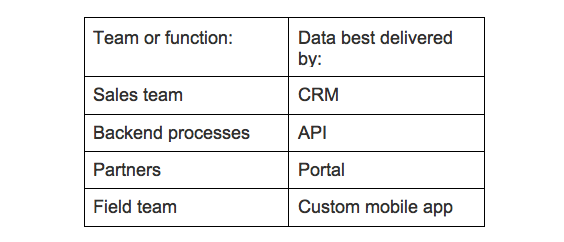 Kids can’t swallow pills, so children’s vitamins are offered in chewable forms instead. While the ingredients matter, the delivery mechanism is equally important if you want your child to eat the vitamins instead of throwing them on the floor. It’s the same concept with anything you want your sales team to use. The delivery is just as important as the content.
Kids can’t swallow pills, so children’s vitamins are offered in chewable forms instead. While the ingredients matter, the delivery mechanism is equally important if you want your child to eat the vitamins instead of throwing them on the floor. It’s the same concept with anything you want your sales team to use. The delivery is just as important as the content.
If you’re working with a Customer Data Platform (CDP), at Openprise we’ve found that it’s useful to ask customers: “Is your CDP data chewable?” Here are five ways to gauge whether your CDP data passes the chewable test and tips to get it there.
1. Is your data of the right scope?
CDP vendors like to talk about a 360-degree view of the customer, as if there’s one monolithic 360-degree view that applies to all users. There isn’t. Every team across your organization has unique needs and processes, and each requires its own 360-degree view. One size does not fit all.
Your CDP needs to produce different data sets for different users quickly and easily. The data set should be exactly what’s needed by each user, no more and no less. In addition, your CDP needs to change data sets quickly to adapt to constant business changes.
2. Is your data integrated?
You don’t want to dump a bunch of disparate data from different systems directly onto users. The data sets should be joined and denormalized for easy consumption. To make your data chewable, your CDP needs to link different data sets together based on the use case requirements. Your CDP also needs to support this agile assembly and reassembly of the data to accommodate different analyses and processes and new business models.
3. Does your data have the right structure?
Data sets often need different structures to support different needs. Take CRM account data: Can you treat each account record independently or do you need to understand the account hierarchy? If the account hierarchy’s important, what level of granularity do you need? Which level of the hierarchy is required?
Your CDP needs to create data structures that fit business requirements for different users. For example, for U.S.-based accounts, a domestic ultimate parent may be the key, but for a Canadian account owned by a U.S. parent, the U.S. parent may take priority over the Canadian domestic ultimate parent.
4. Is your data segmented correctly?
A major value proposition for CDP is the ability to segment the database along different dimensions to enable precise sales and marketing execution. This is key when segmenting unstructured data into structured data — like deriving job function and job level from a job title.
Your CDP needs to create any number of segmentation in an agile manner to meet users’ needs. Different users may have different segmentation requirements. Your North America sales team’s definition of enterprise vs. mid-market vs. SMB may be different from those of your EMEA and APC sales teams.
5. How is your data delivered?
Each team interacts with data in different systems, using different processes and under different contexts. You need the ability to deliver the data in different ways. Here are a few examples:

The easier you can serve up the data required through the right channel using the right mechanism, the more likely your data will have the maximum business impact.
To make your data more chewable, a best-in-class CDP should make data available through many channels, including:
● Populating databases and data warehouses;
● Making data available as an API;
● Creating simple applications and portals to enable direct user interaction;
● Creating browser extensions so users can interact with data from the UI of other business applications; and
● Creating hybrid applications so users can interact with CDP-hosted business logic from the UI of another application.
Takeaways
Depending on the specific needs of your business and the makeup of your users, there are infinite ways to make your data more “chewable.” The basic takeaways include:
● There’s no single monolithic 360-view of data;
● Applying the “chewable” test forces you to focus on user experience and business needs;
● CDP is not just about curating the right data. It’s also about creating the right consumption models for the data; and
● Speed and agility are key to making data chewable because your users are dynamic.
Ed King is the Founder and CEO of Openrpise. He has been building stuff for as long as he can remember. Prior to founding Openprise, Ed was VP of Marketing and Product Management at companies such as Axway, Vordel, Qualys, Agiliance and Oracle. He deployed Marketo three times before doing it again at Openprise. Each time he was handicapped by poor data quality, but no longer.







